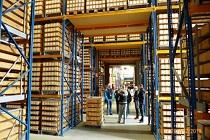 On 16-20 September 2019, representatives of the Polish Geological Institute - National Research Institute (PGI-NRI) visited the Malå branch office of the Geological Survey of Sweden (SGU) and Copenhagen offices of the Geological Survey of Denmark and Greenland (GEUS).
On 16-20 September 2019, representatives of the Polish Geological Institute - National Research Institute (PGI-NRI) visited the Malå branch office of the Geological Survey of Sweden (SGU) and Copenhagen offices of the Geological Survey of Denmark and Greenland (GEUS).
The purpose of these visits was to become acquainted with and to collect information on procedures for collecting, storing and sharing geological information and sampling control in a search for best practices to be applied in planning the central Geological Core and Sample Repository of the PGI-NRI at Leszcze.
The PGI-NRI team comprising Krzysztof Dąbroś, Anna Dąbrowska, Joanna Roszkowska-Remin and Michał Sokołowski held working meetings with SGU staff at the Mineral Resources Information Office in Malå (Västerbotten region, Lappland) on 16-17 September 2019 and with GEUS staff in Copenhagen on 19 -20 September 2019. In accordance with the purpose of these fact-finding visits, SGU and GEUS geological archives staff provided extensive briefings on the functioning of their core repositories and archives of geological material and reports together with methods of maintaining databases and dissemination of geological information.
The briefings were combined with guided tours of the repositories and archives. In the central core repository in Malå, 10,000 sq.m. in area, the SGU stores 3 million meters of core sample drills owned by the State Treasury as well as approximately 1 million meters of core samples owned by business entities. The SGU also maintains a library of scans of core samples, already comprising scans of 230,000 m of core samples. The SGU branch office in Malå also maintains an archive of geological records with approximately 9,500 documents from exploration and documentation of metal ore deposits in northern Sweden. The bulk of these documents are already scanned and the process of their digitization is fairly advanced.

Technical consultations with SGU staff at the core repository of the Mineral Resources Information Office in Malå. Sweden
Dissemination of geological information stored by the SGU takes place on terms defined by the survey itself and is not stipulated in Swedish law. Decisions to make data available to the public free of charge are left to the SGU Director at the request of the Director of the Mineral Resources Department.
The central GEUS warehouse in Rødovre stores 70,000 core samples mainly from approximately 200 oil and gas prospecting wells (including 100 offshore wells). The warehouse also functions as a logistics and supply center for GEUS foreign expeditions.
GEUS stores complete records of collected data in several database systems - holes in the JUPITER (borehole data), GERDA (onshore geophysical surveys) and MARTA (offshore geophysical surveys). Dan Olson from the GEUS presented capabilities of the main GEUS laboratory, where tests of core samples are performed before archiving along with other commercial research. Currently, GEUS does not archive paper geological documentation - all submitted documentation is scanned on an ongoing basis, entered in a database and then eliminated. Archived data is stored on two servers of the service and are copied every five years to servers of the Danish National Archives.

A visit to the core magazine of the Danish geological service in Rødovre near Copenhagen, Denmark
The fact-finding visits to Sweden and Denmark made it possible for the PGI-NRI team to become acquainted with and to collect information on well-tested modern procedures adopted by these surveys in operating repositories of core material and archives of geological samples and reports. Special attention was paid to the fact that both geological services do not carry out sampling control.
The visits made it possible to collect a wealth of information on technical solutions and practices worked out by the teams of SGU and GEUS core repositories and archives of geological samples, including those concerning selection of equipment for core profiling, practices in sample storage and handling, basic tests performed on samples as well as management practices. The information was found to be of remarkable practical value for a further search for best practices to be implemented in planning the central Geological Core and Sample Repository of the PGI-NRI at Leszcze.
The Swedish part of that fact-finding trip was made very productive and constructives thanks to joint efforts of Jerry Hedstrom and Johan Söderhielm of the SGU branch office in Malå, and support and supervision of Erika Ingvald, head of Division of Mineral Information & Mining, and Lisbeth Hildebrand, National Delegate to EGS, and the Danish part – thanks to joint efforts of Jens Jørgen Møller, senior consultant in Department of Geophysics, Mads Engberg Willumsen former head of Department for Reservoir Geology, and Dan Olson, senior researcher. Reservoir Geology, and supervision of managing director Flemming Larsen and Jørgen Tulstrup, National Delegate to EGS.
Within the framework of the fact-finding visit, the SGU organized a guided tour for the PGI-NRI team in (by Swedish standards) the neighboring Kristineberg Mine operating under subarctic climate conditions. Ores exploited in that mine are products of polymetallic mineralisations of the Volcanogenic Hosted Massive Sulphide “VHMS” type. These ores were among the first found in the so-called Skellefte-district, as well as the first to be confirmed through electrical ore prospecting (geophysics) in 1918. They began to be exploited in 1940 and presently the Kristineberg Mine is among the deepest in Sweden with mining at +1100 meters.
Text: Krzysztof Dąbroś
Photos: Michał Sokołowski
Translation and Cooperation: Wojciech Brochwicz-Lewiński














 PGI-NRI offer
PGI-NRI offer Mineral resources of Poland
Mineral resources of Poland  Oil and Gas in Poland
Oil and Gas in Poland 




 Subscribe to RSS Feed
Subscribe to RSS Feed